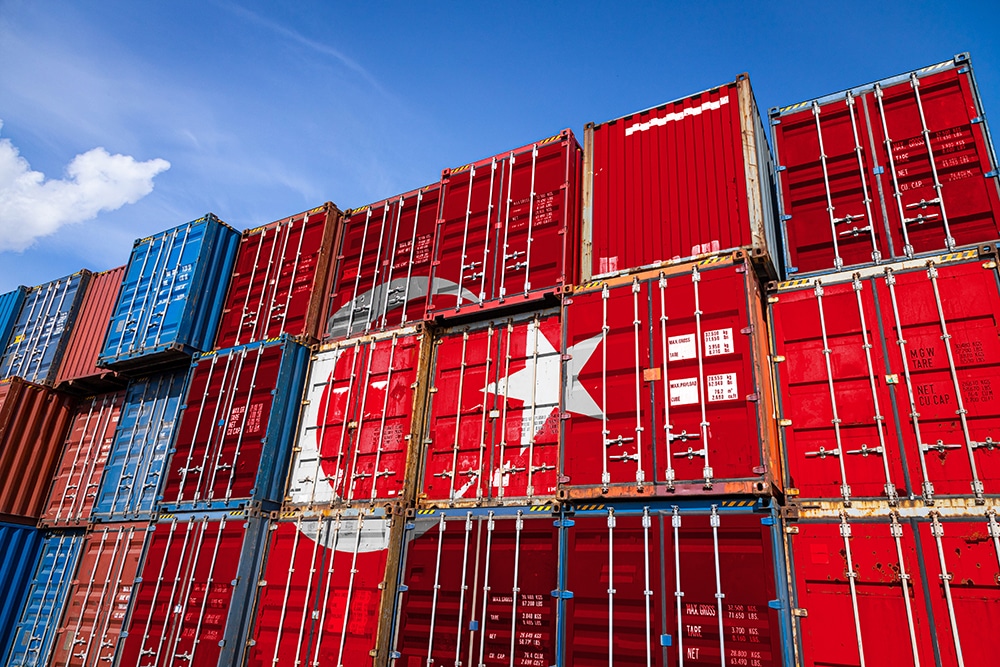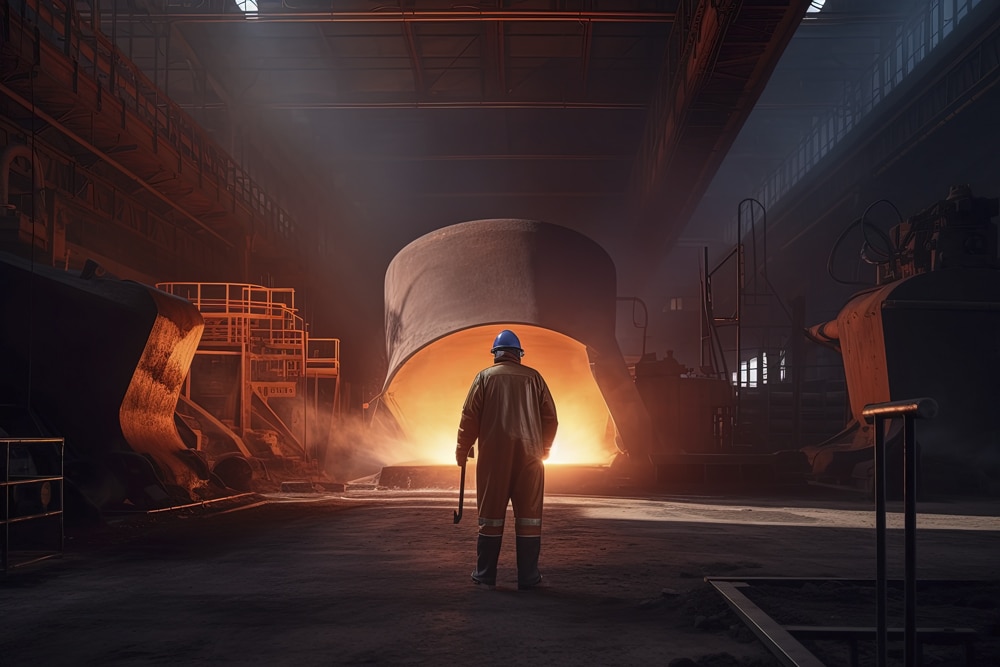Data from the World Steel Association (Worldsteel) released on January 25 indicates that global crude steel production remained largely unchanged year on year. Indeed, steel market analysis says poured liquid steel totaled 1.88 billion metric tons last year, which is similar to the volume poured in 2022. The association also stated that crude steel production in December was 136 million metric tons, down 5.3% from over 143 million metric tons during the same month the previous year.
Level up your steel sourcing game. Join MetalMiner’s weekly newsletter list and get exclusive access to steel market intelligence.
Asian Steel Market Figures
One analyst told MetalMiner that record-high interest rates, slowing industrial production growth in Europe, and a myriad of issues in China prompted mills worldwide to reduce production. The source added that imports from East Asia and Southeast Asia also impacted prices in Europe. However, crude steel from China, the world’s largest net producer, was largely unchanged in 2023 at 1.01 billion metric tons. Worldsteel data shows that volume reflected an increase of just 0.1% year on year. The organization also noted that December crude production in the world’s second-largest economy was 67.4 million metric tons. This represents a 14.9% decrease on the year from 79.2 million metric tons.

Total crude steel production in Asia for all of 2023 totaled 1.38 billion tons, up 0.8% from 1.39 billion tons. Japanese steelmakers poured slightly less than 87 million metric tons, down 2.5% from 89.2 million metric tons. Meanwhile, Taiwan saw a decrease of 8.9% from 20.8 million metric tons to 18.9 million metric tons. Vietnam’s crude production was off 5% from 20 million metric tons, with the country producing roughly 19 million metric tons all last year.
However, Indian steelmakers helped to offset these decreases. Worldsteel indicates the subcontinent saw an 11.8% hike in crude production to over 140 million metric tons in 2023, up from 125 million metric tons in the previous year. That said, Mongolia saw the largest increase in crude production for the Asia region, with a 50% hike on the year. Total crude production from Mongolia came to 38,000 metric tons, up from 25,000 metric tons. One source told MetalMiner that Mongolia’s only steelmaker, Darkhan Steel, has two electric arc furnaces with an annual combined crude capacity of 115,000 metric tons. Further east, South Korean steelmakers poured almost 66.7 million metric tons, up 1.3% from 65.8 million metric tons.
Russia and Eurasia
Eurasian steel markets also largely increased production, even amid ongoing conflicts. Russia and CIS states reported an increase in their crude output, which hit 89.9 million metric tons in 2023. This is a 4.4% increase from the 86.1 million metric tons recorded in the previous year. Worldsteel indicated that Russian steelmakers led the increase at 75.8 million metric tons, up 5.6% from 71.7 million metric tons in 2022. Meanwhile, the country currently at war with Russia, Ukraine, produced just 6.23 million metric tons, off 0.6% year on year from 6.26 million metric tons.
Figures also indicate that Moldova recorded the largest decrease at an estimated 500,000 metric tons. This represents a 10.7% drop from 560,000 metric tons. Moldova’s only steelmaker is the Moldova Steel Works, which sits in the country’s breakaway Transnistria Republic. The plant’s listed crude capacity is 1 million metric tons per year via two electric arc furnaces. Finally, Kazakhstan recorded a 5.5% drop in its crude production to 3.92 million metric tons from 4.15 million metric tons (learn how to best navigate production cuts like these by reading The Art of Timing Your Metal Buy).
The Middle East and Africa
Worldsteel also indicated that The Middle East showed a 1.3% increase in its total crude production, putting out 53.5 million metric tons over 52.8 million metric tons last year. For instance, Iran, the largest producer in the region, poured 31.1 million metric tons of crude. That volume represents an increase of 1.8% from 30.6 million metric tons. The association also noted that Saudi Arabia’s production reached 9.94 million metric tons, up 0.8% from 9.86 million metric tons. Meanwhile, Oman saw a double-digit increase. In total, the Gulf state poured 2.42 million metric tons, reflecting a 21% hike year on year from 2 million metric tons.

According to the data, Africa saw the largest increase of any region. The continent poured a total of 24.2 million metric tons in 2023 – up 5.1% from 23 million metric tons in the previous year. Egypt, the largest producer, poured 10.4 million metric tons, reflecting a 5.4% from 9.82 million metric tons. Another North African nation, Algeria, increased its crude steel production by 2.8% to 4.42 million metric tons from 4.3 million metric tons. Finally, Libya was not only the leader in North Africa, but on the entire continent. That country saw an on-the-year increase of almost one-third, producing 902,000 metric tons from 688,000 metric tons in 2022.
Worldsteel also revealed that South Africa, the largest steelmaker in sub-Saharan Africa, recorded a 10.6% increase in its crude production. The country’s steel market produced 4.87 million metric tons in 2023 compared to 4.4 million metric tons in 2022.
European Steel Market Figures
Amid all this, the European Union (EU) saw its crude steel decline 7.4% to 126 million metric tons. This represents a significant drop from the 136 million metric tons produced in 2022, with almost all member states experiencing decreases. Analysts say declining steel market prices in Europe against higher input costs are what prompted many steelmakers to reduce their production.
Worldsteel indicates that the 27-member bloc’s economic powerhouse, Germany, recorded a 3.9% drop in crude poured in 2023. The reported figures were 35.4 million metric tons, down from 36.8 million metric tons in 2022. Meanwhile, Poland poured almost 6.44 million metric tons in 2023, reflecting a 13.1% drop year on year from 7.4 million metric tons.

That said, steelmakers in the Czech Republic saw volumes decrease by almost a quarter. Worldsteel figures were 3.38 million metric tons in 2023 against almost 4.29 million metric tons in 2022, representing a 21.1% year-on-year decrease. However, Romania’s crude output came to just 1.58 million metric tons in 2023, down almost 40% from 2.62 million metric tons. Analysts say that low levels on the Danube River created logistics difficulties at Liberty Steel’s Galati plant in eastern Romania, prompting the plant to stop production in Q4.
Interested in following global macroeconomic factors like this on a monthly basis to better plan our your metal spend? Opt into MetalMiner’s Monthly Metals Index report and stay posted on 10 different metal industries.
Slovakia and Portugal
Meanwhile, increases in Slovakia and Portugal helped to offset the blocs, as both states recorded double-digit increases. For example, Portugal’s crude steel production totaled 2.05 million metric tons, reflecting a 10.5% rise from the 1.85 million metric tons poured in 2023. Slovakia saw an even larger increase as its crude production surged to 4.47 million tons. That represents an increase of more than 15.4% from the 3.87 million metric tons the country poured in 2022. Indeed, only Croatia had a larger increase, with production up by one-third. That said, the actual totals were much smaller. Worldsteel estimates Croatia’s steel market output at 220,000 metric tons against 169,000 metric tons the previous year.

In the “Other Europe” category, Worldsteel showed that total crude production was down 4.5%, reaching 43.5 million metric tons from 45.6 million metric tons. The largest producer in that region, Turkey, poured 33.7 million metric tons, but that was still down from the 35.1 million metric tons seen in 2022. The United Kingdom, which officially left the European Union in 2020, recorded a 6.5% decrease to 5.57 million metric tons from 5.96 million metric tons.
North and South America
Moving westward, worldsteel’s report indicated that North America’s crude production was down 1.7% to almost 11 million metric tons. That decrease came largely from Mexico, where steelmakers poured just 16.3 million metric tons in 2023. This represents a 11.6% year-on-year decline from 18.4 million metric tons. Further south, crude steel production in Cuba, El Salvador and Guatemala decreased by a total of 15.7%, though each of the three countries reported relatively small volumes. Indeed, Canada was the only country in the category to report any real increase. The United States’ “neighbor to the north” poured about 12.3 million metric tons in 2023, up 1.3% from almost 12.1 million metric tons in 2022.
South America reported a 5.7% decrease in its crude production. Worldsteel notes the continent produced a total of 41.5 million metric tons, down from over 44 million tons. Brazil, the continent’s largest steelmaker, saw its crude production decline 6.5% to 32 million tons from 34 million tons. Meanwhile, Peru poured 1.65 million metric tons, down 6.5% from 1.76 million metric tons.
Start custom mapping price points for your specific needs using MetalMiner Insights – your path to cost-effective steel sourcing. Ready to learn more?




